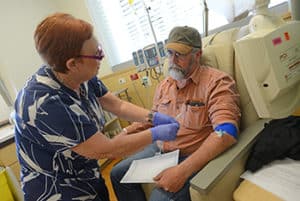
Probably few people would say Carl Guenther’s diagnosis was lucky, although he says so, and he has agreement from the world’s foremost expert on Castleman disease, Frits van Rhee, M.D., Ph.D., at the University of Arkansas for Medical Sciences (UAMS).
Guenther, a Wilmington, Ohio, father of two, was diagnosed with Castleman disease and given two years to live just months after his wife died of ovarian cancer. The lucky part? His doctor, who had recently completed medical training, remembered the disease from textbooks and correctly diagnosed it – no easy feat for a rare disease with no formal diagnostic criteria, van Rhee said.
“The average oncology doctor may see one Castleman disease patient in their lifetime, so you cannot possibly expect them to be an expert on a really rare disease,” van Rhee said. “In my opinion, people will die of this disease because they will not get the correct diagnosis, the diagnosis will be delayed, or they will receive inappropriate treatment.”
Patients with Castleman disease overproduce lymphocytes, leading to enlarged lymph nodes, and they have night sweats and fever. They may also have liver failure, renal failure, accumulation of fluid in the chest and abdomen, respiratory failure and death. The tumors that can result from the disease are usually benign, but Castleman can progress to malignant lymphoma.
“Although it’s a lymph node disorder, sometimes lymph nodes can look like Castleman disease due to other disorders, particularly diseases like lupus and autoimmune disorders,” van Rhee said. “So just looking at the microscope and saying ‘This looks like Castleman disease’ is not sufficient.”
Having the right diagnosis helped Guenther find van Rhee, who 10 years ago enrolled him in the life-saving international study of the drug siltuximab, the first-ever drug for Castleman disease approved in 2014 by the Food and Drug Administration and the European Medicines Agency.
“I lucked out,” Guenther said.
Siltuximab is a major advance in the treatment of multicentric Castleman disease, an aggressive form of the disease that kills about 38 percent of patients within five years. With the new drug, the percentage of survivors should increase based on clinical trial results showing siltuximab successfully treated 34 percent of patients with multicentric Castleman disease.
Still, with the disease affecting an estimated 4,000 to 6,000 people in the U.S. alone, that leaves many without effective treatment. The drug is also not a cure, so patients like Guenther will have to take siltuximab the rest of their lives to avoid relapse.
Second Act
It took international collaboration among physician researchers and their patients to get siltuximab to market. That same kind of collaboration is being used in hopes of continued groundbreaking discoveries and other advances such as standard diagnostic criteria, van Rhee said.
Van Rhee is a founding member of the Castleman Disease Collaborative Network (CDCN), a worldwide community of physicians, researchers, patients and supporters working to combat the disease. Research and patient support are core missions for the CDCN, linking people through its website, www.cdcn.org. The website’s components include patient information, such as where to find medical treatment, and the latest information about the disease. The group is also developing diagnostic criteria for physicians to help remove the element of luck.
“You have a disease that is fairly complex and it’s very rare, so that’s a set up for failure to some extent isn’t it?” van Rhee said. “That’s why it’s important to get some solid information out there. “
The CDCN is developing a patient registry and biorepository of tissue and blood samples to aid with its research component. Much of the organization of the collaborative and its website development has been led by one of van Rhee’s patients, David Fajgenbaum, M.D., M.B.A. His inspiring success story while battling Castleman disease was recently featured in the Philly Voice.
A major barrier to finding and tracking Castleman disease patients is the lack of ICD 9 codes for the disease. Used primarily for billing purposes, such international codes are entered into medical records and stored in databases, giving researchers the ability to query them and to track how many people have certain diseases. The CDCN is pursuing ICD 9 codes for three major forms of Castleman disease: Multicentric Castleman disease; idiopathic (unknown cause) multicentric Castleman disease, and Unicentric Castleman disease, a form in which lymph nodes are enlarged in one area and can usually be cured with surgery.
The CDCN also raises money for research. One of its funded studies is being led by van Rhee, who hopes to identify a specific “fingerprint” for Castleman disease by analyzing the blood proteins of patients.
“Although Castleman disease is suggested to always be driven by Interleukin 6 (a protein involved in inflammation and infection responses), there are some patients who get sick without developing high Interleukin 6 levels,” van Rhee said. “So we want to have a better understanding of the biology of the patients.”
